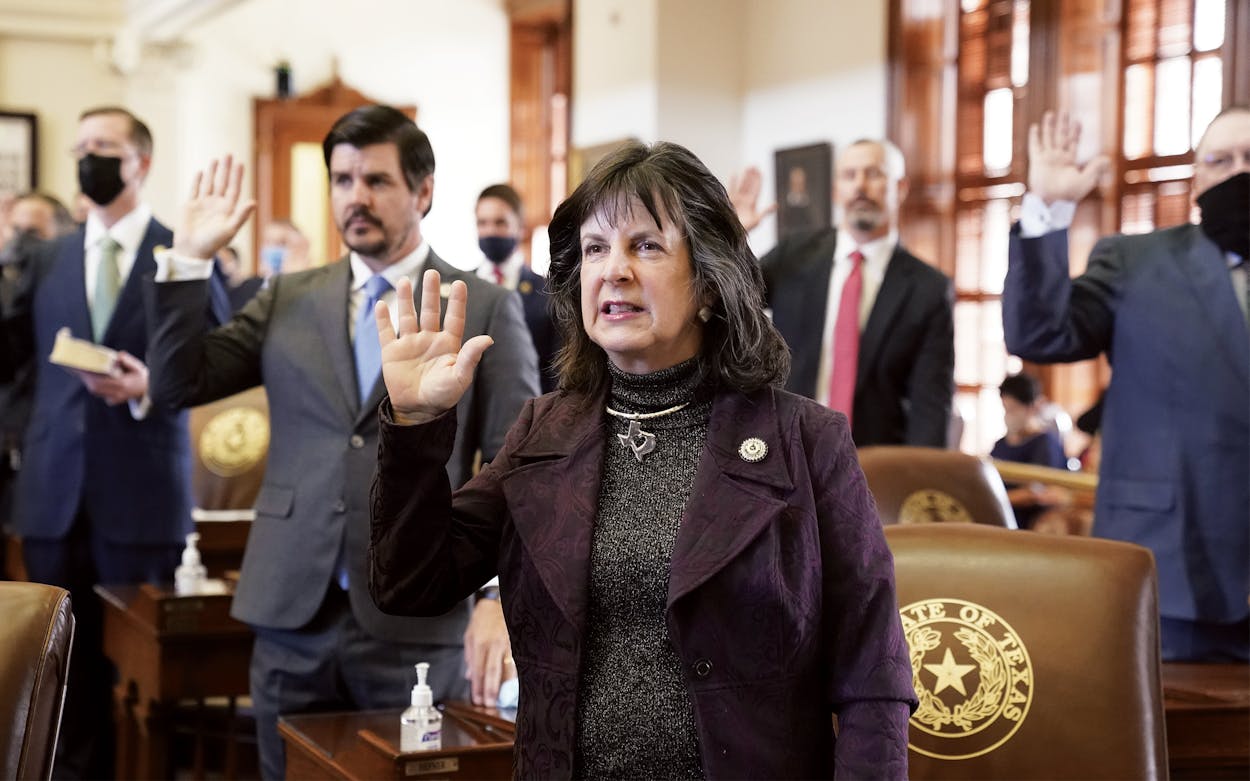Texas Republicans have gotten more and more creative in imagining the dangers transgender folks pose to the state. Last legislative session, Senator Charles Perry of Lubbock argued they were endangering girls high school sports, despite his not being able to identify a single instance of a transgender athlete participating in a Texas school athletic competition. Last week, U.S. senator Ted Cruz raised worries about “transgender witch” pilots crashing planes. And now, a right-wing lawmaker has conjured a new threat: transgender kids in juvenile detention.
On Thursday, Valoree Swanson, a Republican from the northern Houston suburbs, filed H.B. 3213, which would require juvenile detention centers to detain and house inmates based on the sex noted on their birth certificates. There is no data on what percentage of kids in juvenile detention in the state are transgender, but 1.42 percent of Texans age thirteen to seventeen identify as trans, and research indicates such children are disproportionately likely to be incarcerated (researchers speculate that the reasons for this include higher likelihood of family abandonment, drug use, and discriminatory treatment). Currently, when transgender children enter the juvenile criminal justice system in Texas, housing assignments are made on a case-by-case basis, in accordance with federal standards. (Despite those federal standards, when it comes to adults, an NBC investigation in 2020 found that all 891 transgender women then imprisoned in Texas were held in mens’ prisons, and all 89 transgender men were housed in women’s prisons.)
Swanson’s legislation appears to be motivated by the same thinking, backed by scant evidence, that drove Lieutenant Governor Dan Patrick’s failed “bathroom bill” back in 2017: the idea that males are posing as transgender women in order to prey on girls. Officially titled the “Juvenile Girls Protection Act,” the name of Swanson’s bill is a misnomer. All available evidence indicates that, if passed, the act would place juvenile girls—specifically those who are transgender—in greater danger.
Systemic sexual abuse has long plagued Texas’s juvenile prisons. In 2019, the Justice Department released a study on the victimization of youth behind bars. According to the research, 7.1 percent of youths in juvenile detention across the country reported enduring sexual abuse. Those numbers were even higher in the three Texas youth prisons surveyed. In the Ron Jackson State Juvenile Correctional Complex, west of Waco, for example, 14 percent of young inmates reported sexual abuse at the hands of staff or other inmates. In 2021, the Department of Justice announced a civil rights investigation of Texas’s juvenile detention facilities in response to high rates of abuse by staff; that investigation is currently ongoing.
Across the country, prison rape and sexual abuse is horrifyingly common for prisoners of all backgrounds. Right-wingers often point to specific incidents of transgender inmates sexually abusing others behind bars. Studies have found, however, that transgender inmates experience significantly higher rates of abuse compared to cisgender prisoners. In 2007, researchers studying California state prisons found that transgender prisoners were thirteen times more likely to have been sexually abused than cisgender inmates in the same prisons.
Evidence indicates this increased victimization holds true for youth in lockup. The U.S. Bureau of Justice Statistics has found that non-heterosexual youth inmates were much more likely to have endured violence by another inmate compared to their heterosexual peers. And while there’s been less research on transgender youth specifically, young transgender inmates across the country have reported serious abuse. In 2016, a nineteen-year-old trans girl who had spent two years in male juvenile detention and halfway houses in Texas told the Associated Press that she’d been attacked and jumped by groups of male inmates. She was sent to the hospital twice after separate beatings.
Federal prison regulators have long recognized that transgender inmates face a high risk of sexual abuse behind bars. In 2003, after then-president George W. Bush signed the Prison Rape Elimination Act, a federal task force began a long-term study of ways to prevent sexual violence in prisons. In 2012, when the nonpartisan group issued new guidelines, it recommended specific rules for the treatment of transgender inmates. The PREA regulations stipulate that, “In deciding whether to assign a transgender or intersex inmate to a facility for male or female inmates, and in making other housing and programming assignments, the agency shall consider on a case-by-case basis whether a placement would ensure the inmate’s health and safety.” The regulations also outline that “a transgender or intersex inmate’s own views with respect to his or her own safety shall be given serious consideration.” If Texas were found in noncompliance of the PREA standards, the DOJ could decrease Texas’s federal prison grant funding by 5 percent, or a little more than $4 million.
Swanson is aware her bill contradicts the existing standards to prevent prison rape. “Pursuant to the Prison Rape Elimination Act National Standards for Juvenile Facilities,” she writes in the bill, “the Texas Juvenile Justice Department . . . shall consider the unique safety needs of each juvenile on a case-by-case basis, and shall take appropriate action to ensure a juvenile’s health and safety.” But she stipulates that “appropriate action” cannot include housing trans inmates in any facility other than one that matches the sex on their birth certificates.
If juvenile detention officials considering “safety needs of each juvenile on a case-by-case basis” determine those juveniles aren’t safe in a facility that doesn’t match their gender identity, what options does that leave them under the proposed law? Swanson’s bill gives no details about what “appropriate action” might look like. Texas can’t create transgender-only jails—another one of PREA’s regulations states that “the agency shall not place lesbian, gay, bisexual, transgender, or intersex inmates in dedicated facilities, units, or wings solely on the basis of such identification or status.” Swanson’s bill fails to provide other options. Her purpose appears to be the creation of a double punishment for transgender youth offenders: first, punishment for their crimes, and then punishment for being transgender.
- More About:
- Politics & Policy
- Texas Legislature






